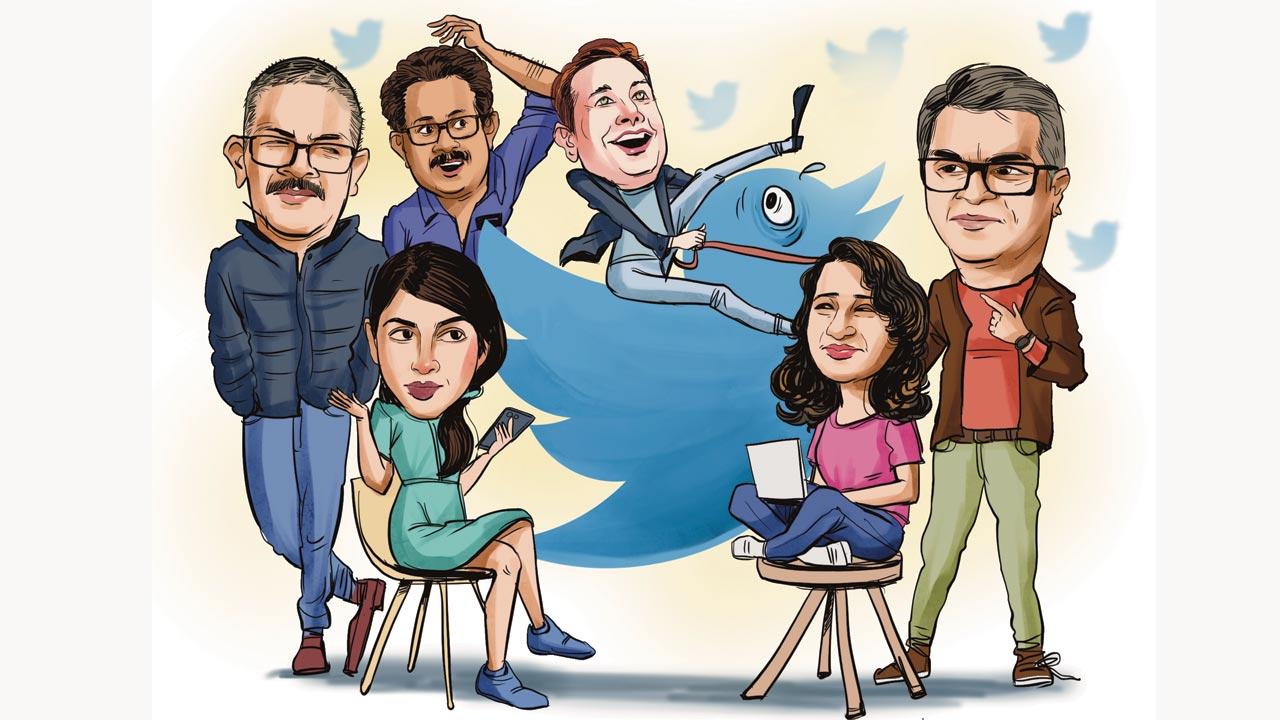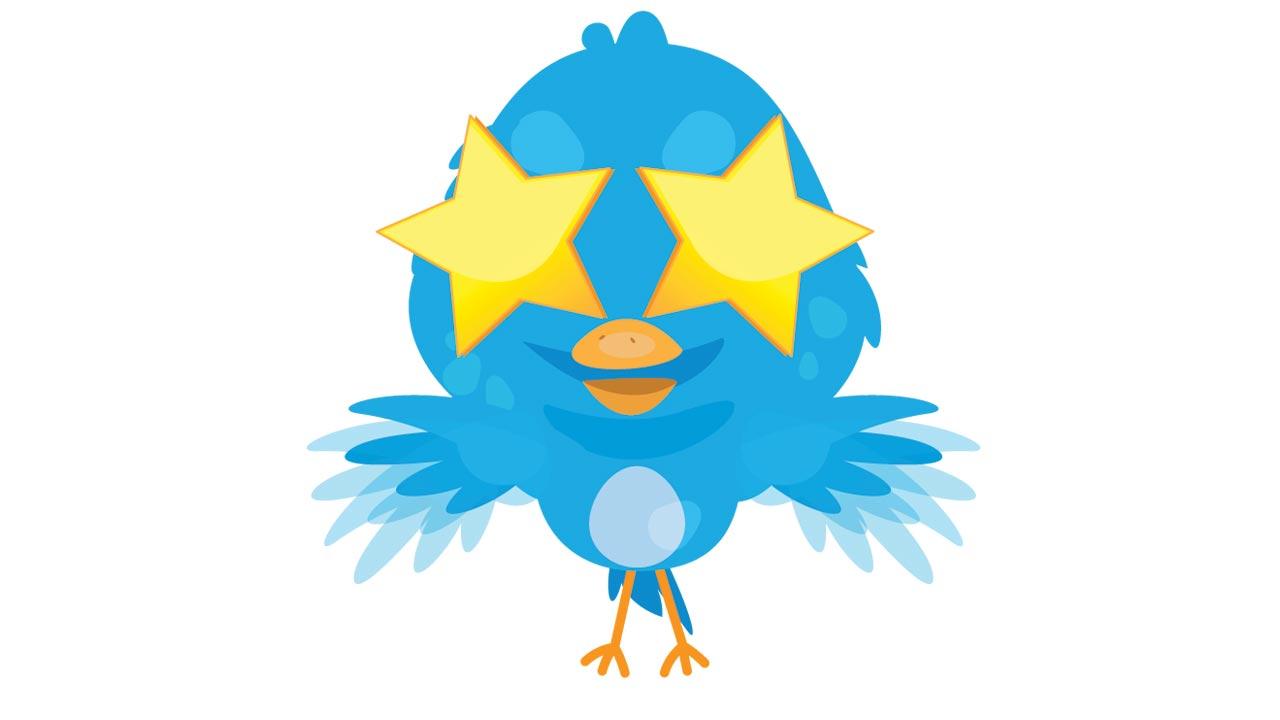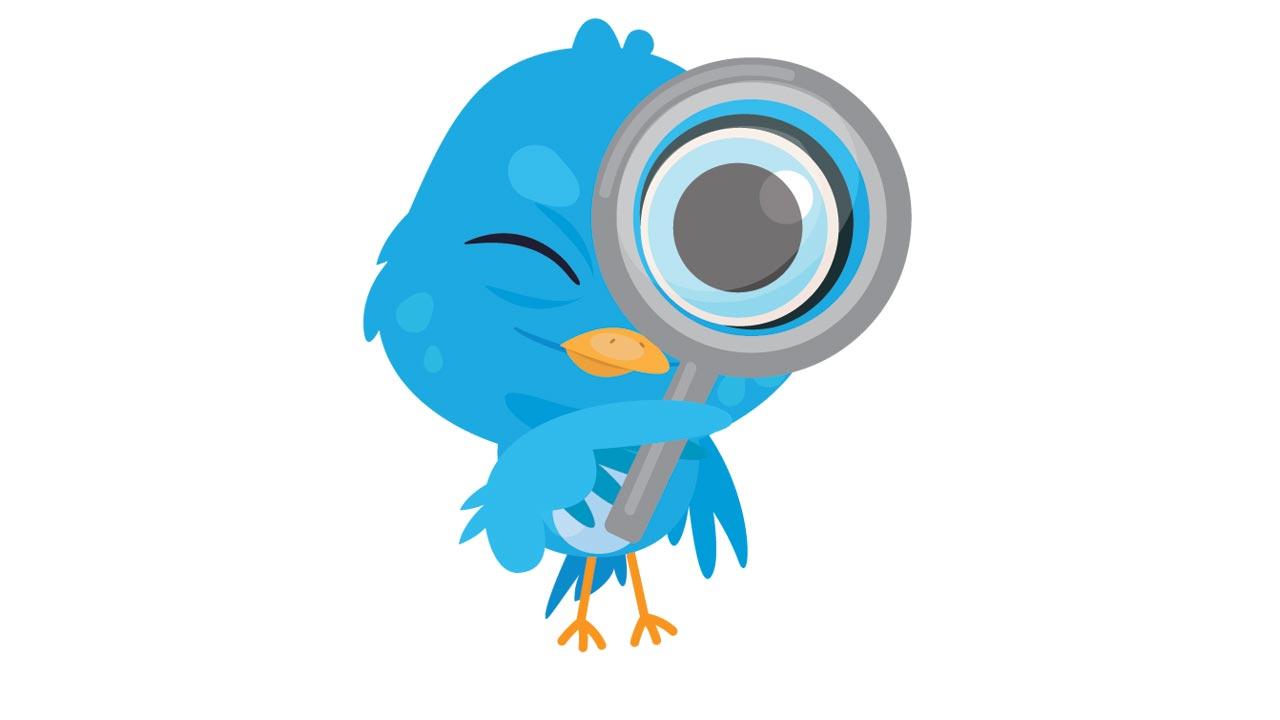Five of the microblogging site’s most effective account holders regale us with stories of using it to influence snowballing change and what they’ll do if Musk leaves it unrecognisable

James Wilson Engineer, Data analyst; Atul Khatri, Standup comedian; Sandhya Fernandes, Digital marketer; Shivendra Singh Chauhan, Co-founder-India Against Corruption Movement and Padmapriya Janakiraman Actor-dancer, Co-founder-The Women in Cinema Collective
On October 27, Elon Musk became the owner and CEO of Twitter in a hostile $44-billion bid and introduced multiple changes to the company. He celebrated the landmark acquisition by tweeting, “The bird is free”. Ever since, Twitter’s 7,500 staffers have been facing bizarre challenges every day, including having to put up with the American billionaire’s eccentric decisions and explosive tweets.
On November 19, everyone woke up to the rumour that Twitter could shut down because mass resignations had left its offices devoid of coders. Twitter Inc. announced that it was temporarily closing its offices after Musk had issued an ultimatum to his employees: Stay with the company “working long hours at high intensity” or quit with three months’ severance pay. The closure, insiders said, came after two-thirds of the staff opted for the second option.
ADVERTISEMENT
It prompted several users to quit the platform, share eulogies and flowery goodbyes.
 Illustration/Uday Mohite
Illustration/Uday Mohite
One week later, on November 22, Musk tweeted, “Wasn’t Twitter supposed to die by now or something?”
Even if it hasn’t, it has surely changed forever.
According to the National Contagion Research Institute (NCRI), an independent, American organisation that forecasts and reports potential cyberthreats, the use of racial slurs and the N-word on Twitter rose by 500 per cent on October 28. The following week, tweets that included the word “Jew” had increased fivefold since before the ownership transfer. Tweets with the most engagement were overly anti-semitic. There has also been an uptick in misogynistic and transphobic language.
Long-time users are obviously trying to wrap their head around the changes. Sunday mid-day spoke to five users, all ardent fans of Twitter, who used the platform effectively to influence public change during some of the most critical social and political movements in India in recent times, about what they make of this mutation.
‘It has become important development in world civilisation’
James Wilson, Kollam-based civil engineer and data analyst
@jamewils offered one of the best data-mining tracks on demonetisation and the COVID-19 pandemic outbreak
“IT was in 2009 that I joined Twitter. I was weaning away from Facebook after it had become less about networking and more like a personal-sharing platform fraught with privacy issues. Around then, I was part of the [long-disputed] Mullaperiyar Dam cell, where I was special officer for the Kerala government, providing information on the issue for the Supreme Court. The colonial-era dam has long been a source of friction between Tamil Nadu and Kerala. But, I was toying with the idea of leaving this assignment, and going back to my original posting with the Kerala State Electricity Board Limited. On a whim, I started a blog, offering clarity on issues related to the dam, also sharing it on my Twitter feed. It was when Dr Shashi Tharoor re-tweeted one of these posts that I received a lot of views—at one point, over 1.5 lakh people had seen it. But after that, I continued to use Twitter like anyone would, mostly retweeting other users’ tweets. I had nothing to add to it really, until November 8, 2016, when Prime Minister Narendra Modi announced demonetisation of R500 and R1,000 notes in the country in the interest of attacking alleged accumulation of black money and fake currency.
I already had a fascination for data analysis. So, for the first few days, I observed what was going on, reading reports and gathering information put out by the Reserve Bank of India. Nobody was talking about how much money was being taken out of the system, and whether the BJP government was able to bring back new notes effectively into the system, and truly flush out black money.
I spent the next few months deciphering how this would affect the currency in circulation, and shared my analysis on my blog and Twitter. For instance, in a detailed piece I shared on December 21, 2019, titled ‘A monumental disaster in the offing,’ I examined the current output capacity of printing presses to print and replace demonetised notes that the RBI called Specified Bank Notes (SBN), and the possibility of outsourcing the work to any high quality security presses abroad.
Around this time, my tweets got noticed by senior journalist Shekhar Gupta, who described my handle as “the best data-mining track on #demonetisation flip-flops”. The posts caught the attention of a galaxy of journalists, academics, politicians and economists, including the RBI. I was invited to write columns for several publications, as well. My follower count took off suddenly, and it made me feel more responsible about the kind of tweets I was putting out.
Following the COVID-19 outbreak, I used data to examine the spreading pattern of the disease, offering projections on Twitter based on my knowledge of mathematics and experience in data analysis. I wished to understand where India really stood in the fight against the virus while everyone was lauding the government for its efforts. I advocated more testing and found the Indian Council for Medical Research’s (ICMR) criteria of testing only symptomatic patients to be “limited and rigid”. It was following the “don’t test, don’t find” approach. As part of my research, I analysed data sourced from ourworldindata.org, and discovered that by July 2020, India had completed 1.2 crore tests. This meant that we were conducting 8.98 tests per 1,000 people of India’s population. I compared this with the US (121.7), Russia (159.61), Canada (85.13) and Australia (118.49). The difference was glaring.
Twitter has a massive reach, and over the years, it has become an important resource-sharing platform, unlike any other. Whenever there has been breaking news, it first breaks here. Think about the Russia-Ukraine war. It has become an important development in world civilisation. Many platforms
have attempted to replicate it but failed. So, its absence, if that’s what’s being predicted, will create a gaping hole. I don’t think it will die suddenly—yes, it may see a slow death, if no course correction is done. Elon Musk can be quite erratic, so I hope at some point, he keeps Twitter’s interest at heart, and steps back.”
‘It’s where I raise my voice on local civic issues’
Atul Khatri, Mumbai-based standup comedian
@one_by_two has been raising local civic issues that affect the average Mumbaikar and keeping the humour going
“I have been a Twitter user longer than I have been a comedian. Once I entered the profession, Twitter organically became the place where I would test my jokes—the more RTs a joke would get, the better it was likely to work in front of a live audience. I would make it the premise of my next set.
But truth be told, the platform had turned toxic over the last few years. I began to get trolled for the simplest of posts, including something banal like, ‘It’s a beautiful morning in Mumbai’. Somebody would get up and say, ‘Hey, you are talking about your beautiful morning while people in Ukraine are dying!’
But I stayed on because it offered me news. It is here that most newsbreaks happen. In fact, it is this platform where I learnt how to differentiate between a fake journalist and someone who is fighting for truth. Twitter comes alive during the elections, when a lot more people get active on it, sharing interesting news and articles from the remotest parts of the country.
Twitter is also where I get heard on civic issues that bother me and other Mumbaikars, like the recent traffic chaos caused by the closure of Gokhale bridge in Andheri.
If Twitter changes and becomes unrecognisable, I will miss it for the news. Elon Musk has taken knee-jerk decisions and most of them have fallen flat—America’s giant pharma company Eli Lilly lost $15 billion due to Twitter’s blue subscription policy, which led people to take a fake account seriously. But perhaps once Musk settles in, he may make the place less toxic. We can’t turn a blind eye to his past achievements at Tesla.”
‘If content is paid, how will we conduct advocacy?’
Padmapriya Janakiraman, Delhi-based actor, dancer, producer
Used @padmapriya_Offl to call out Malayalam superstar Dileep’s role in a sexual assault of a fellow actor in 2017, and challenged his reinstatement into the Association of Malayalam Movie Artists (AMMA) in 2018. Along with members of the Women in Cinema Collective, she also argued for workplace equality
“Social media has been very important to us—by us, I mean the Women in Cinema Collective (WCC). We use Twitter, Facebook and Instagram to put our messaging out. There is no doubt that a sense of democracy and freedom exists on these platforms.
I started with Facebook, and slowly shifted to Twitter, where all the important conversations seemed to be happening. It began with sharing information about the cause we were supporting—that of equal rights as artistes in the Malayalam film industry.
This was long before the #MeToo and #TimesUp movement gained steam in India. Some of us actors [Revathy, Parvathy Thiruvothu, among others] came together to start the WCC. It was instituted a few months after one of our female colleagues was abducted and assaulted in February 2017. We needed to stand by the survivor, and fight this cause for all women.
We led a campaign in June 2018, to protest the reinstatement of actor Dileep to the AMMA, despite his alleged involved in the assault. On October 7, the AMMA executive committee decided no action will be taken against Dileep. We then wrote another letter demanding that AMMA take a decision on their stand on Dileep by October 9.
All through this time, social media became an important tool to share our concerns. We even called out [Malayalam superstar] actor Mohanlal [president of AMMA] for taking an ‘apathetic stance’ towards the survivor.
Finally, on October 20, in an AMMA meeting held in Kochi, Mohanlal made it clear that he had called Dileep and had asked him to tender his resignation.
We were heavily trolled, but we kept on—we tried to change the narrative around the survivor, who until then was treated as a victim and shamed. Thanks to social media, the solidarity worked for us in terms of the larger public coming together and rallying around us. On Twitter, the amount of goodwill we generated, and the amount of people we reached out to, was massive.
Many people came out in support—Actor Prithviraj expressed his solidarity in an interview; the Congress leadership reached out to the WCC, and demanded the CPI(M) to clarify whether it would take action against an MP and an MLA who are members of the committee that took the decision to reinstate Dileep. Many of our supporters on Twitter also said that they would be boycotting the movies of the so-called “superstars”. Writer NS Madhavan tweeted: “Worst #Metoo incident happened not in Hollywood, but in Kerala, when an actor allegedly paid money to a gang to get an actress raped. The case is on, but male chauvinist pigs of Malayalam actors’ guild, AMMA, are shouting ‘me too’, ‘me too’ in support of the accused!”
Will Twitter continue to be the space where people come out in solidarity? With the new changes that have been unfolding recently—and I hear that content may become paid—I wonder how someone like me will conduct advocacy, and reach out to the right people.
But it’s a good clarion call. It’s telling us that it’s not wise to rely on one particular medium. This means we need to return to the time of free internet space. Maybe Reddit will take its place. But yes, we have to accept that these are not permanent fixtures, and we need to start thinking beyond.”
‘It’s a habit now; has grown too big to fail’
Shivendra Singh Chauhan, Delhi based ex-journalist and co-founder of India Against Corruption (IAC) Movement
@shivendravats mobilised citizens for support during the anti-corruption protests of 2011 and 2012, concerned with the introduction of the Jan Lokpal bill

“Those were the early days of social media and Facebook, Twitter, were still new in India. I think the India Against Corruption Movement sort of spurred their growth in the country, and the impact we saw was huge. There were millions of citizens involved and political parties hadn’t anticipated our SM reach. In 2011, the Twitter handle of Jan Lokpal was the second most influential handle after NDTV. When it came to messaging and taking the communication across to the people, we started by posting information about events and rallies in various parts of the country and how people could join these offline.
What’s happening with Musk’s arrival is momentary. He is a maverick and if what he has done with Tesla and SpaceX is anything to go by, I wouldn’t write him off quickly. He’s seeing things which we are not able to see perhaps.
At the end of the day, a business has to make money. The layoffs might look atrocious for now, but in terms of bringing the company back to profitability, they might be needed. People talk about what’s going on at Twitter on Twitter, so the decisions and their impact may be magnified and feel strange. But this happens in a lot of organisations.
It’s too big an entity to fail. It has become a habit. After the blue tick verification move, I think new changes will be considered more pragmatically and weigh in on their outcome. It is the go-to place for information and news and there is no real competitor at the moment.
‘Has more potential to affect change than any other platform’
Sandhya Fernandes, Thane-based digital marketer
With a group of changemakers, she started @SOSSaviours, spreading across corporations in Maharashtra to offer real time medical help and lead patients and families to resource providers during the pandemic
“Twitter was the one platform, all of us soon realised during the pandemic, that could offer real-time updates about who needed what help across the country, and who was available to provide it. I was able to reach out to bureaucrats, politicians, ward officers, the BMC and several others in positions of power, directly via Twitter. Tagging them brought immediate attention to COVID-19 cases in emergent need for a hospital bed, an ambulance, oxygen, a Remdesivir injection, blood or medicines. And the politicians and officials realised they could not remain silent if someone was holding them accountable on a public platform. Not just establishing communication with officials, it also helped with the speed at which we were able to identify individuals who could be of assistance. Neither Instagram nor Facebook offered us the same results.
If not for Twitter, nobody would have known that a certain Sandhya in Bombay is trying to join the dots and help out. I went from a follower base of 50 to 5,000. The first patient I helped was someone critical waiting for a bed at 3 am at a Powai hospital. I managed to get them a bed by 5 am at Sion hospital. Fifteen days later, he was fit for discharge.
If the platform shuts down or changes, it will be an opportunity for real help lost. Its speed of communication, minus hate-mongering and the presence of bots, gives Twitter more potential for social change than any other platform. Interference will mean a loss to small towns especially, that were just about getting used to the platform’s power for change.”
Changes made. More to come

Pay Per View: Twitter is working on a feature that will let users post videos and charge others to view these, with the company taking a cut.
Blue tick on sale: Starting November 29, the platform may allow users to buy verification at $8/month. The blue verified tick of verification lets people know that an account of public interest is authentic. Those who pay may enjoy additional benefits including “priority in replies, mentions and search”. The company also rolled out a “grey official” tick for governments, media outlets, corporations and some public figures. This is not for sale.
Vine revival: Musk is considering the revival of Vine, which was acquired by Twitter in 2012, and was a popular short-form video app that minted several internet stars before it faded and was shut down.
Say what you like: Musk has promised that he will make Twitter a haven for “free speech.” Not surprisingly, Donald Trump’s account was reinstated 22 months after it was suspended when a pro-Trump mob attacked the US Capitol.
Identity rules: Musk has said that no one is allowed to parody anyone without clearly mentioning the word “parody” in their name, and not just “bio”.
By: Jane Borges, Heena Khandelwal, Aastha Atray Banan, Nidhi Lodaya, Yusra Husain
 Subscribe today by clicking the link and stay updated with the latest news!" Click here!
Subscribe today by clicking the link and stay updated with the latest news!" Click here!








